A recent toxicological study, conducted by Alex Roberto Melgar Figueroa and submitted as a Ph.D. dissertation to the Faculdade de Ciências Farmacêuticas de Ribeirão Preto in Brazil, has assayed the neurotoxic effects of ayahuasca in laboratory rats. The abstract, in Portuguese and English, is here, and the full text — alas, only in Portuguese — is here. “The results of this investigation,” the author reports, “indicate the presence of oxidative stress in rats treated with ayahuasca, with statistically significant values of neuronal apoptosis measured by TUNEL assay.” In other words, the author says that ayahuasca killed off brain cells in experimental rats. What can we make of this?
The study
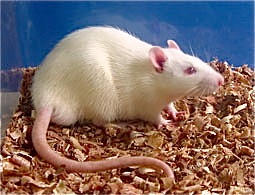 |
| Wistar rat |
In many ways, this was a pretty typical design for a toxicology study. There were two groups of twelve Wistar laboratory rats each. Over a period of twenty-one days, the control group was given, by gastric gavage, two mL of water, and the treated group was given, by the same means, two mL of an ayahuasca drink diluted half-and-half with water. At the end of the twenty-one days — this is considered to be a subacute study — the rats were killed, dissected, and their organs given a variety of tests, to see if there were any statistically significant and toxicologically relevant differences between the two groups. The study reports two such differences.
Increase in apoptotic neuronal cells
Apoptosis is a form of programmed cell death in multicellular organisms. As opposed to necrosis, which is a form of traumatic cell death that results from acute cellular injury, apoptosis is often useful. If cells do not die off in an orderly way, the result can be a number of cancers, autoimmune diseases, inflammatory diseases, and viral infections. On the other hand, out-of-control cell death can lead to neurodegenerative diseases, hematologic diseases, and tissue damage or atrophy. The TUNEL or terminal deoxynucleotidyl transferase dUTP nick end labeling assay is one of the main methods used to identify cells in the last phase of apoptosis.
In this study, the author reports, the rats given ayahuasca showed a statistically significant increase in apoptotic neuronal cells as measured by the TUNEL assay in comparison with the control group.
Decrease in serum glutathione and hepatic vitamin E
Chemically reactive molecules, such as oxygen ions and peroxides, are a natural byproduct of the normal metabolism of oxygen and, at low levels, play an important role in a number of cell functions. However, under some conditions, the level of such molecules can increase dramatically, resulting in damage to cell structures. This higher level of reactive oxygen species is called oxidative stress.
Oxidative stress can occur for either or both of two reasons — an increased production of oxidizing molecules, or a significant decrease in the effectiveness of antioxidant defenses, such as glutathione and vitamin E. This inability of the cell to detoxify reactive molecules or repair the harm they have caused can damage all components of the cell. Even moderate oxidative stress can trigger apoptosis. Low levels of antioxidant molecules may indicate that detoxification of reactive oxygen species is impaired.
In this study, the author reports, the rats given ayahuasca showed a statistically significant decrease in serum glutathione and hepatic vitamin E in comparison with the control group.
The conclusion
The author ties together these two statistically significant differences by concluding that the findings “suggest the presence of a neurotoxic process in Wistar rats treated with ayahuasca tea over a subacute period, probably triggered indirectly by oxidative stress factors.”
Limitations of the study
There are several limitations in this study relevant both to its conclusions and to any attempt to extrapolate those conclusions to human beings. Some of these limitations are common to any rodent bioassay, while others appear to be unique to this study.
Method of administration
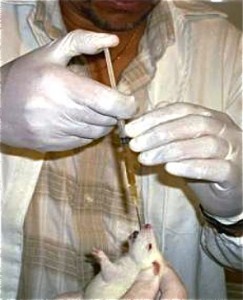 |
| Administering ayahuasca by gastric gavage (photo by A. R. Melgar Figueroa) |
First, we should note that in this experiment the rats were dosed by gavage — that is, a tube was stuck all the way down their throats into their stomachs and the ayahuasca was pumped in. Presumably this was done because intravenous or intramuscular injection might bypass relevant gastrointestinal metabolic and detoxification processes. Gavage also has the advantage of ensuring that a measured dose actually enters the stomach. But still, gavage is very different from the usual way that humans ingest ayahuasca, and it is unclear what effect — if any — this method of administration had on the outcome.
The rats
The rats used in the study were standard albino male Wistar laboratory rats, currently one of the most frequently used rat strains for laboratory research. Such rats have proven to be useful models for human neurological deficits. Researchers have identified rat equivalents of akinesia, tremor, postural deficits, and dyskinesia, all relevant to Parkinson’s disease in humans. Rat models of hemiplegia, visuospatial neglect, and tactile extinction have been useful in assessing the outcome of ischemic or traumatic brain injury, and in monitoring the effects of therapeutic interventions for these conditions.
But there are certainly differences between rats and humans. Rats do not have gall bladders. All the bile they use is produced by their liver, which is proportionately much larger than that of humans. The rat gastrointestinal tract has a much smaller absorptive surface area than that of humans, and thus absorbs materials more slowly and to a lesser extent. Rats, unlike humans, cannot vomit the contents of their stomachs.
And the rats in this study seem to have had some significant problems of their own.
First, in an earlier pilot study to test the dose originally planned for the experiment, ten rats were each given three mL of ayahuasca, by gastric gavage, every day for five days. Four out of the ten rats died during the course of the pilot study — a very high mortality rate. As a result, in the experiment itself, the concentration of ayahuasca was halved by mixing it one-to-one with water and the dose reduced to two mL of this diluted ayahuasca per day. No explanation is given for the death of the rats in the pilot study, and we do not know if there was something wrong with the rats, with the ayahuasca, or with the laboratory conditions under which the rats were kept.
But then, relevantly, two rats in the control group — that is, rats given only water — died during the course of the experiment. The two animals began to show signs of anorexia, lethargy, and nasal secretion approximately one day before they died. On necropsy, apart from nasal hyperemia — an unusual amount of blood in the nasal mucous membranes — there were no significant findings in any organ. The two dead rats were simply disregarded in the statistical analysis of the study, and the control group was analyzed as having had just ten rats.
Then one of the treated rats died, in the same way, on the same day it was to be sacrificed for study. As a result of this death, the treated group is sometimes statistically analyzed as having had twelve and sometimes as having had eleven rats.
There is no indication as to whether the deaths of the study rats were different from or similar to the deaths of the pilot rats.
Finally, in each of the two groups, only six of the twelve rat brains were analyzed for neural apoptosis. There is no explanation given for this, except for the statement that evaluation of the six remaining brains was, in some unspecified way, “infeasible.” No explanation is ever given as to what this infeasibility might have been.
The ayahuasca
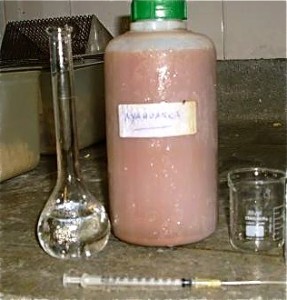 |
| Sample of ayahuasca used in the experiment (photo by A. R. Melgar Figueroa) |
We know very little about the provenance of the ayahuasca drink used in the experiment. But there are three things we do know that can help us evaluate its results.
First, different batches of ayahuasca can differ significantly in their components. Studies of ayahuasca drinks from the Upper Amazon and Brazil have shown that the mean amount of DMT in different samples ranged from 12.5 to 60 mg/100 mL, and the mean amount of total β-carbolines ranged from 20 to 668.33 mg/mL. This is very significant variation. Without having an analysis of the specific drink given to the rats in the experiment, it is risky to make assumptions about just what was in it.
Second, we know that 40 percent of the rats in the pilot study died within five days when given 3 mL of the undiluted ayahuasca drink each day. As noted above, this may have been a problem with the rats, but it may also have indicated there was a problem with the ayahuasca. Clearly the author thought it was the latter, at least at the time, since he cut the dose from the 3 mL per day of the pilot study to the one mL per day of the experiment.
Third, we know that the ayahuasca had fermented. Due to the presence of an odor of alcohol in the ayahuasca, the author analyzed its contents and discovered that it contained 0.37 percent ethanol, an amount he considered “too low and unlikely to influence the study.” It is unclear how he came to this conclusion, and whether or in what way the effect of fermented ayahuasca might differ from that of unfermented ayahuasca, in rats or in humans.
The dose
Let’s do some math. The Wistar rats used in the study, the author tells us, weighed 200 g, which seems about right for their age of 30-45 days postnatal. The average lifespan of a Wistar rat is about two to three years — let’s say 30 months. Every day for 21 days each rat received 1 mL of ayahuasca — a dose of 0.005 mL/g.
An average human weighs about 70 kg and lives for about 840 months. Twenty-one days in a rat’s lifespan of 30 months is roughly equivalent to 20 months — or a bit more than a year and a half — in a human’s lifespan. Using the author’s own figures, the average human dose of ayahuasca in a ceremonial context is 150 mL — a dose of 0.002 mL/g.
In other words, the human equivalent of what the rats were given would be to drink two and a half doses of ayahuasca every day for more than a year and a half. Such human consumption of ayahuasca would be unusual.
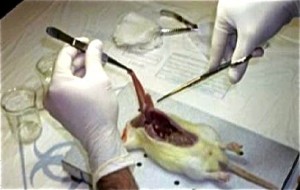 |
| Surgically removing the rat liver (photo by A. R. Melgar Figueroa) |
There are several justifications given for such high-dose studies in animals. High-dose animal experiments are often justified as an attempt to to find out the effect the substance might have on the most vulnerable human populations, such as infants, the elderly, the sick, and the immunocompromised. Doses higher than any human might reasonably ingest and administered to healthy rats are used as a surrogate for lower doses ingested by unhealthy humans.
Another justification is that high doses are a surrogate for a longer lifetime — that is, short-lived rats given high doses are a surrogate for longer-lived humans ingesting smaller doses over a longer period of time.
A third justification is that a substance may have an adverse effect on a relatively small number of people who ingest it. That is why clinical trials for drugs, which may enroll only a thousand or so humans, often miss adverse effects that become apparent only after the drug has been approved and distributed to hundreds of thousands of patients. In this case, a small number of rats — pure-bred laboratory rats are expensive to buy and maintain — are given very large doses in the hope that this will turn up any relatively rare adverse effects. In other words, dose is used as a surrogate for population size.
There is huge debate over all of these justifications. The problem is that these justifications are ultimately less scientific than they are regulatory and prudential. The goal is to screen out substances that may adversely affect the sick, the elderly, infants, and the immunocompromised; to detect otherwise rare adverse effects in larger human populations; and to predict long-term low-dose effects — all in a cost-justifiable brief study with a relatively few rats.
Importantly, too, high doses of a substance in a brief time may trigger entirely different metabolic pathways than would lower doses over the same or a longer period of time. Higher doses may, for example, overwhelm detoxification mechanisms that would work just fine at lower doses. Metabolites of high-dose metabolic pathways may be more toxic than those of low-dose pathways.
Two anomalies
There are two anomalies in the study results that are worth discussing here — the negative results of the caspase-3 fluorometric assay and the statistically significant decrease of malonaldehyde levels in the treated rats.
Negative caspase-3 fluorometric reaction
Caspase-3 is an enzyme that is activated during the cascade of events associated with apoptosis, and should normally be detected when apoptosis is occurring. Given the positive result of the TUNEL assay, it is surprising that no significant difference in caspase-3 levels was detected between the treated and control rats. Another way of putting this is that the presence of apoptosis reported by the TUNEL assay in the treated rats was not confirmed by a caspase-3 fluorometric reaction.
Decreased levels of malonaldegyde
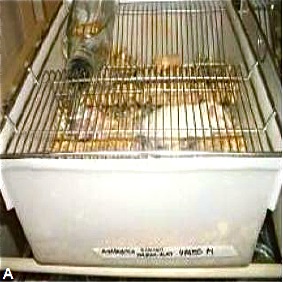 |
| Rats in the treated group in their cage (photo by A. R. Melgar Figueroa) |
In the same way, malonaldehyde levels are a marker for oxidative stress, so malonaldehyde levels should be increased if oxidative stress is taking place. While levels of serum glutathione and hepatic vitamin E were significantly decreased in the treated group — which the author takes as a failure of antioxidant defense mechanisms and thus indicative of oxidative stress — serum malonaldehyde levels were also significantly decreased in the treated group, which is precisely the opposite of what one would expect. Another way of putting this is that any oxidative stress indicated by decreased levels of glutathione and vitamin E was not confirmed by any increased levels of malonaldehyde.
Indeed, these reported results appear less consistent with runaway oxidative stress than with increasing levels of reactive oxygen species being successfully dealt with by antioxidant defense mechanisms. The author speculates that the decreased levels of malonaldehyde in the rats given ayahuasca may be due to an antioxidant effect of the β-carbolines in the ayahuasca drink. But it is hard to see how he can then argue that the ayahuasca drink is at the same time responsible for the purported oxidative stress.
Interpretation
There are four additional factors that I think need to be considered when weighing the impact of this study on possible human neurotoxicity, and before legal and regulatory decisions are made at least in part on that basis.
First, although there are equivocal indications of neuronal apoptoses, nowhere does the study demonstrate anything even approaching any behavioral indications of brain damage. There was no tremor, ataxia, weakness of extremities, or postural or balance deficits in any of the rats given relatively high doses of ayahuasca.
Second, the rats were sacrificed while still being dosed with ayahuasca. There was no washout period to allow for all of the administered drug to be eliminated from the body. If indeed this particular sample of ayahuasca administered at this dosage was producing oxidative stress and neuronal apoptoses, we would want to see if and when the animals recovered — that is, if and when antioxidant defenses returned to normal and any apoptotic neurons were replaced and reintegrated by neuroplastic processes.
Third, there was only a single treated group of rats. It is therefore impossible to say whether the reported effects are dose-related, what the shape of such a dose-response curve would look like, or whether there is any threshold for the effects reported.
Fourth, the study must be read in the context of the admittedly limited epidemiological studies of actual human beings who have in fact ingested ayahuasca over much longer periods of time — the Shuar in the Upper Amazon, Brazilian members of the União do Vegetal, and American members of Santo Daime. Such studies have revealed no evidence of psychological or neurological harm from the regular ingestion of ayahuasca under conditions of ceremonial use.
An anti-ayahuasca bias?
In Brazil, the use of ayahuasca as a religious sacrament in the various ayahuasca churches — União do Vegetal, Santo Daime, Barquinha — is highly politicized. While the churches and their use of ayahuasca are legal in Brazil, there remains considerable controversy, and studies such as the present one are likely to be cited in public debate both in Brazil and abroad. And there is certainly some reason to perceive an anti-ayahuasca subtext in the present study.
At the outset, the abstract refers to ayahuasca as “controversial because of its indiscriminate use by some groups of people,” although such groups are never identified and what makes their use indiscriminate is never made clear.
The study also appears to misread some of the current ayahuasca literature — and in an anti-ayahuasca direction. The author, for example, cites Robert Gable’s risk assessment of the ritual use of ayahuasca for the claim that we should consider “the use of ayahuasca as a positive reinforcer for potential abuse of other substances” — a claim that Gable himself explicitly refuses to make. In the same way, he cites Dennis McKenna’s article on the therapeutic potential of ayahuasca for the proposition that “the pattern of use by adherents of the syncretic religions can be classified as recreational,” whereas in this article McKenna clearly and consistently keeps religious and recreational uses distinct.
Putting these statements together, the message appears to be that religious groups that use ayahuasca do so indiscriminately and recreationally, and that the use of ayahuasca in these groups is a gateway to abuse of other substances. I am aware of no reputable study that supports such claims.

- Previous Post: Fourteen Dead Shamans
- Next Post: Vodka, Ayahuasca, Found Footage
- More Articles Related to: Ayahuasca, Research Studies



Good work, yet again, Dr. Beyer.
I would like to see a study done on the curanderos who have drunk several times a week over decades. It’s an unproven cliche, but all of them seem to do quite well in their later years and often live lives that are full and vigorous. This study seemed to be designed to prove ayahuasca is unsafe. That alone should disqualify it during peer review.
The problem with an epidemiological study of old shamans is that it would be subject to a selection bias — that is, the study would systematically exclude people who had experienced adverse effects from drinking ayahuasca and who thus never became shamans. The well-known study of long-time members of the UDV suffers from the same selection bias — that is, it excluded people who drank ayahuasca a few times and then dropped out, for whatever reason. Of course, finding and including such dropouts would be logistically difficult, but no one ever said it was easy being an epidemiologist. :-) The study had another selection bias as well. Long-time members of the UDV are already selected for traits of being rigid, loyal, frugal, orderly, and persistent compared with controls.
Yes, I agree a more rigorous chemical analysis (and description of that analysis) is needed of the ayahuasca used in this study. For instance, did it contain Datura or Toe — which as, you know, many traditional ayahuasceros still prefer to include in their brew.
Granted, I haven’t read the article (and won’t until it is translated,) it’s really hard to draw any solid conclusions until we know, in more specific chemical terms, what the rats were being subjected to — there are so many discrete chemical agents that could potentially be in the research admixture, without isolating them it is hard to make any specific judgements about harm. But the fact that the rats were dying left and right suggests there was some serious issue with either the brew or the method of its administration.
“This study seemed to be designed to prove ayahuasca is unsafe. That alone should disqualify it during peer review.”
I would agree with quoted statement. It seemed a bit sketchy on the sample and method of administration~fermented?
This also stood out and initial thought as to the “abroad”~”Studies such as the present one are likely to be cited in public debate both in Brazil and abroad”
Many would likely want to see the aspect of a healthful hallucinogen go away, without details you can assume several of my thoughts on this matter.
The upside of this being no real conclusive result, which does show a lack of any great bias, as these tests could have been done with guided results. As is the case with so many “safe” claims of such things as environmental, big pharm drugs and food sources.
I would also remark that rats being unable to vomit can be a very relevant factor. As most people here probably knows already, vomiting is a common phenomena when humans drink ayahuasca, and it’s commonly understood (and felt, by myself) as a purging or cleansing proccess. There may be a physiological basis to this (expelling toxins, excesses…?), there may be not, but this being such a important part of the human-ayahuasca relationship, it should be clearly aknowledged, and can have some relation with the reported neurotoxic effects.
“I would also remark that rats being unable to vomit can be a very relevant factor.”
Is it not also possible that there is some kind of self regulating factor regarding dose and vomiting? My personal experience leads me to at least suspect that if someone ingests a dose of Ayahuasca that is either physically or psychologically too much for them, their body may purge sooner than later in order to auto-regulate the dosage.
Obviously I’m not advocating relying on this and not paying attention to appropriate dosage for those serving the tea; I’m just suggesting it may be a factor to consider in relation to the mice not being able to vomit, and therefore not able to self regulate.
Please forgive my lack of knowledge, but I was under the impression that avoiding foods that containe tyramine was very important when consuming ayahuasca. If the ayahuasca had fermented could there not be high levels of tyramine? If so,could the high levels of tyramine account for the neurotoxicity the study attributes to the ayahuasca?
“Examples of foods and drinks with potentially high levels of tyramine include liver and fermented substances, such as alcoholic beverages and aged cheeses.” from wikipedea http://en.wikipedia.org/wiki/Monoamine_oxidase_inhibitor
This study reminds me of when they suffocated mice in cannabis smoke to prove it causes brain damage.
Pretty sure the presence of alcohol is a bad thing. That stuff causes hangovers!
here is a study of the antioxidant activity of harmala alkaloids.
http://mutage.oxfordjournals.org/content/22/4/293
Stay thirsty my friends
2016 OLYMPICS!
I’m way beyond my depth here, but i have read that alcohol is associated with Apoptosis. I have no idea how high the concentration of alcohol in ayahuasca could get, but concentrations of 12-15% in wine are average. Why should the author of the study attribute the increase in apoptosis to ayahuasca when there is an other well documented culprit present in the study?
Thanks for putting together this study Steve. I’ve been curious about this exact topic for a while. I read Singing to the Plants a while back, and have been excited to spend a lot of time in the Amazon.
I appreciate all your great work on this topic.
What a horrible torture for these innocent rats? Was this study really so necessary? seriously. disgusting
It looks like the ayahuasca was stored in a plastic container too. Being highly acidic, ayahuasca should never be stored in plastic because it will leach the chemicals from the container. It should always be stored in a glass container.
disgusting using rats for experiments.
high does of ayahuasca and the rats are unable to purge? disgusting using rats for this experiment… there is no end to human ignorance.
i would be interested in analysis related to envenomated people, as I am aware that autoimmune conditions caused by envenomation are treat with jergon sacha and ayahuasca …
Great research about ayahuasca. It’s just a different story when ayahuasca is used to people instead of rats. Ayahuasca is a medicine and should be more studied on how it can help people cure many diseases.